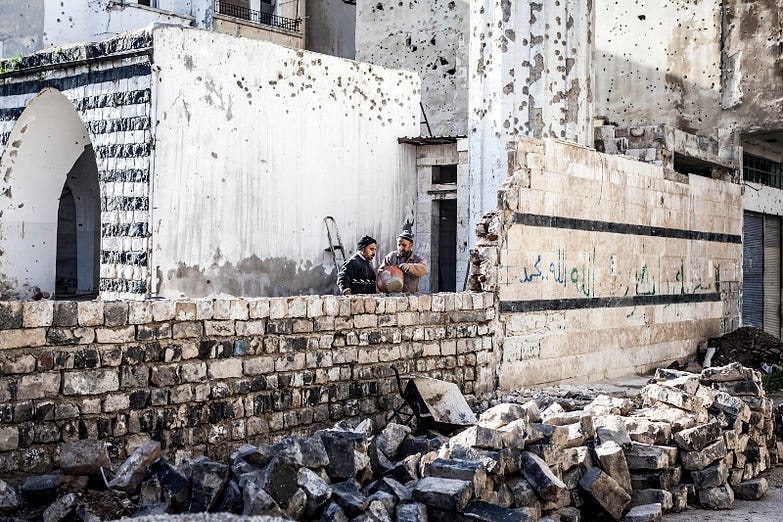With armed conflicts taking place in so many parts of the Muslim world, the Islamic law of war is as indispensable as ever for the protection of civilians and other persons hors de combat. Over the centuries, classical Muslim jurists have provided impressive legal literature, which, just as international humanitarian law (IHL), brings humanity in war. Emphasizing the universality of IHL’s principles, which transcend legal traditions, civilizations and cultures, is absolutely essential for improving respect and protection for victims of armed conflict in the Muslim world.
This article is also available on Medium.
By Dr Ahmed Al-Dawoody, Legal Adviser (Islamic Law and Jurisprudence), ICRC. The ideas expressed in this article are the author’s own.
Origins of the Islamic law of war
The emergence of Islam, in 610 A.D., threatened the religious, political, economic, and social systems then in place in Arabia. Hostility towards the followers of the new religion gradually rose, and they were forced to flee the birthplace of Islam, Mecca, twice: first to Abyssinia (today, Ethiopia) in 615 A.D. and then to Yathrib, now Medina in Saudi Arabia, in 622 A.D. This hostility continued even after the flight to Medina, and there were a number of violent encounters, including battles, between Muslims and their enemies.
This aspect of Islamic history is dealt with briefly in the Qur’ān; it is recorded in great detail in the sīrah literature, (biography of the Prophet, early Islamic history) which gives the numbers of the dead and those taken prisoner, and sometimes their full names as well. The hadith literature (sayings, deeds, and tacit approvals of the Prophet) also contains thousands of reports on this subject. In order to fully understand these bodies of literature and to derive laws from them, even experts have also to study and examine other bodies of literatures, including tafsīr (exegeses of the Qur’ān), and hadith methodology; they have to do this in order to determine the reliability of the various narrators and the authenticity of the various reports from this period.
Studying the points of correspondence between Islamic law and modern IHL is not a matter of intellectual luxury: it is of strategic importance in ensuring that IHL principles are observed in armed conflict.
All these bodies of literature constituted the material, or the texts, from which the fuqahā’, or jurists, developed the Islamic law of war in the literature of fiqh, or Islamic law, under such headings as al-jihād, al-siyar, al-maghāzī; to these headings, contemporary Muslim scholars add those of akhlāq al-ḥarb (the ethics of war) and al-qanūn al-dawlī al-insānī fī al-Islām (international humanitarian law, or IHL, in Islam).
This brief introduction shows where, in what sources, the Islamic law of war can be studied. It also explains how differences in interpretation of these sources are among the reasons why there are contradictory regulations, and major violations, in connection with the use of force by Muslims.
Sources of the Islamic law of war
The sources or the tools used by Muslim jurists to develop the Islamic law of war include the following: 1) the Qur’ān; 2) the Sunnah (tradition of the Prophet); 3) early Islamic precedents, mainly until about 661 A.D.; 4); consensus among the jurists; 5) jurists’ rulings reached through analogy; and 6) the public interest.

It is worth adding here that in Islam, a treaty is binding unless it blatantly violates the dictates of the religion in some way. It is a matter of some significance that since the seventh century, Islamic law has been developed by individual, and independent, Muslim legal scholars who belonged to either the Sunni or the Shiʻite sect. In addition, each of these scholars was an adherent of one of numerous schools of law: of these schools, four are now most prominent in the Sunni world (the Ḥanafī, Mālikī, Shāfiʻī, and Ḥanbalī) and three among Shiʻītes (the Twelvers, Zaydis, and Ismāʻilīs).
Because the development of the Islamic law of war rested on specific texts dealing with seventh-century contexts of war, and because of the nature of the tools involved in the law-making process, Islamic regulations on the use of force frequently contradict each other. These contradictions are also partly owing to the fact that Islamic law remained uncodified throughout Islamic history, apart from twentieth-century codifications of what was mainly family law. Moreover, as a consequence of European colonialism, Islamic law was replaced, in all but a handful of Muslim countries, by the French or the English legal systems; because of this, Islamic law in most areas, including the law of armed conflict, has remained a purely academic matter.
With regard to international law, including IHL, a consensus has existed since the founding of the United Nations, among scholars and States in the Muslim world, that these bodies of law are in consonance with the true spirit and ultimate objectives of Islam, but not necessarily with all the rules developed in the past by classical Muslim jurists operating in a very different political context. This is why all Muslim countries have signed the Geneva Conventions and other relevant international treaties.
However, in recent times, serious violations of IHL have been justified by selectively invoking certain classical juristic opinions or interpretations of the scriptures, or simply through analogy to certain classical situations of war — in order, for instance, to justify the killing of civilians. It should also be noted, however, that some other non-State Muslim armed groups have drawn up codes of conduct that are based on Islamic law and that are also in harmony with modern IHL principles. This shows that Islamic law is being both used and abused in contemporary armed conflict in the Muslim world.
Studying the points of correspondence between Islamic law and modern IHL is therefore no longer just a matter of intellectual luxury; it is a subject of strategic importance and of great value in ensuring that IHL principles are observed, to the greatest extent possible, in this specific context of armed conflict.
Characteristics of the Islamic law of war
Because of the uniqueness of the texts and sources, and the contexts (past and present), from which it is derived, the Islamic law of war — which is used to regulate the conduct of hostilities in armed conflicts — has a number of characteristics that should be taken into consideration:
(1) religious basis: because Islamic regulations on the conduct of hostilities are derived from the Islamic scriptures;
(2) religious motivations: it encourages believers to follow Islamic regulations on the conduct of hostilities in order to be rewarded by God in the Hereafter and also to avoid God’s punishment, let alone the State’s;
(3) self-imposed: for the reasons given above and regardless of the conduct of adversaries though jurists sometimes used the principle of reciprocity to lift restrictions on certain weapons or tactics; (It should be kept in mind that there were no international treaties governing the use of force when the Islamic law of war was formulated.)
(4) contextually and textually based: obviously, throughout Islamic history, jurists differed on the interpretation of texts and contexts in connection with the Islamic law of war, which led to
(5) regulations on the use of force that contradicted each other. These contradictory rulings were also a result of the jurists having to balance Islamic restrictions on the use of certain indiscriminate weapons and methods of warfare — to humanize armed conflict, so to speak — with the military necessity of winning a war. This explains
(6) the wide gap between theory and practice: while Islamic law includes detailed regulations that are, remarkably, largely in agreement with modern IHL principles, serious violations of IHL are now being committed by some Muslims.
Because of these characteristics, the Islamic law of armed conflict will continue to be used, or at least referred to, by Muslims who use Islam as their source of reference. Moreover, because of its contextual and sometimes contradictory rulings, the Islamic law of war is sometimes erroneously used to justify harming protected persons and objects.
On the other hand, and as shown below, the similarities between IHL principles and the Islamic law of war suggest that these two legal traditions have the same objectives and that modern IHL principles are of great practical help in directing conduct of hostilities during contemporary situations of conflict. Emphasizing the universality of IHL principles, which transcend legal traditions, civilizations and cultures, is absolutely essential for ensuring compliance with IHL.
Principles of Islamic international humanitarian law
The vast and detailed Islamic legal literature concerned with regulating armed conflict reveals that classical Muslim jurists had in mind more or less the same philosophy and principles that inform modern IHL. Interestingly classical Islamic legal literature distinguished between international and non-international armed conflicts. The significance here is twofold: first, the rules on the use of force in non-international armed conflicts are much stricter and more humane than those for international armed conflicts; second, because of certain precedents in early Islamic history, Islamic law identified four different categories of non-international armed conflicts which have different regulations on the use of force.
The Islamic law of war sought to humanize armed conflict by protecting the lives of non-combatants, respecting the dignity of enemy combatants, and forbidding damage to an adversary’s property except when absolutely required by military necessity or when it happens unintentionally, as collateral damage.
The following are the core principles of Islamic international humanitarian law.
1. Protection of civilians and non-combatants
Islamic law makes it abundantly clear that all fighting on the battlefield must be directed solely against enemy combatants. Civilians and non-combatants must not be deliberately harmed during the course of hostilities. According to the Qur’ān 2:190: “And fight in the way of God those who fight against you and do not transgress, indeed God does not like transgressors.” Several reports attributed to the Prophet in which he specifically mentioned five categories of people who are afforded non-combatant immunity under Islamic law: women, children, the elderly, the clergy, and, significantly, the ʻusafā’ (slaves or people hired to perform certain services for the enemy on the battlefield, but who take no part in actual hostilities).

The ʻusafā’’s various duties on the battlefield at the time included such things as taking caring of the animals and the personal belongings of the combatants. Their equivalent in the context of modern warfare would be medical personnel — military and civilian — military reporters and all other categories of people in the army of the adversary party that do not take part in actual hostilities; these people, too, cannot be targeted. The companions of the Prophet and succeeding generations of jurists grasped the logic guiding the prohibition against targeting these five categories of people, and provided non-combatant immunity for other categories of people as well, such as the sick, the blind, the incapacitated, the insane, farmers, traders, and craftsmen.

However, members of these categories of protected people will lose their non-combatant immunity if they take part in hostilities. Classical Muslim jurists investigated various interesting cases involving participation by such protected people in hostilities and deliberated on the permissibility of targeting these people.
These cases included the following: a woman who actually fights on the battlefield or throws stones at Muslim army soldiers or patrols the enemy’s forces or uses her own money to finance the enemy’s army; and a hermaphrodite (whose appearance gives no conclusive proof of gender) encountered during combat. Other cases involved a child or an elderly person taking part in direct hostilities, and an elderly person brought to the battlefield to plan the enemy’s operations. Regardless of the nuances of their deliberations and their different rulings on the permissibility of targeting these protected people, the mere fact that they investigated these cases and reflected on them proves beyond doubt that the principle of distinction and the doctrine of non-combatant immunity were major concerns for the majority of classical Muslim jurists.
2. Prohibition against indiscriminate weapons
In order to preserve the lives, and the dignity, of protected civilians and non-combatants — and even though the weapons used by Muslims in the seventh and eighth centuries were primitive and their destructive power limited — classical Muslim jurists discussed the permissibility of using indiscriminate weapons of various kinds, such as mangonels (a weapon for catapulting large stones) and poison-tipped or fire-tipped arrows. According to the Qur’ān 5:32: “For that We have decreed upon the children of Israel that whosoever kills a human soul except in retribution of committing fasād (destruction, damage) in the land, it shall be as if he killed all of humanity, and whosoever saves it [a human soul] it shall be as if he saved all of humanity.” The fact that these indiscriminate weapons were the subject of discussion also indicates a genuine concern for enemy property and a wish to protect it, as shown below.

It should be added here that the permissibility of using such indiscriminate weapons was investigated in connection with situations other than those involving combat between individuals. For instance, jurists considered whether such weapons may be used against an enemy fighting from fortified positions. In situations like these, it would obviously be extremely difficult to avoid causing incidental harm to protected people and objects. All this again goes to show that the principle of distinction was the rationale for discussing the permissibility of using these indiscriminate weapons.
Balancing this humanitarian principle with that of military necessity, most of the jurists permitted shooting at the enemy fortifications with mangonels, but they disagreed sharply on the permissibility of shooting fire-tipped arrows at enemy fortifications: one group prohibited it, another expressed its dislike for this method of warfare, and a third permitted it in those instances when military necessity called for it or when it was retaliation in kind. Conflicting rulings of this kind create major difficulties when the Islamic law of war is used as the source of reference in contemporary armed conflicts, because they can be used selectively to justify attacks against protected civilians and objects.
3. Prohibition against indiscriminate attacks
Motivated by the same concerns that led them to investigate the rightness of using mangonels and poison-tipped or fire tipped-arrows (means of warfare), classical Muslim jurists also discussed the permissibility of two potentially indiscriminate methods of warfare that could result in the killing of protected persons and damage to protected objects: al-bayāt (attacks at night) and al-tatarrus (the use of human shields).
The rationale for studying the lawfulness of night fighting — an issue that first arose during a discussion between the Prophet and his companions — was that it did not involve fighting between individuals because they cannot see each other at night. Mangonels and similar weapons were mainly used against an enemy at night, which increased the risk of protected persons and objects being harmed. Similarly, they found that attacking human shields might also cause incidental harm in two instances they studied: to persons protected from the enemy or to Muslim prisoners of war.
Time and again, the need to balance the humanitarian principles of distinction, proportionality and precaution with the principle of military necessity, led the jurists to make contradictory rulings: some of them prohibited attacks made at night or against human shields, others disliked these methods, and still others were willing to permit them, but only when absolutely required by military necessity. They also disagreed about what constituted military necessity. There was, however, no difference of opinion among them on the fundamental point: that protected persons and objects were not to be deliberately harmed.
4. Protection of property
In the Islamic worldview, everything in this world belongs to God, and human beings — as His vicegerents on earth — are entrusted with the responsibility of protecting His property and contributing to human civilization. Hence, even during the course of hostilities, wanton destruction of enemy property is strictly prohibited.

The first caliph Abu Bakr (d. 634) instructed his army commander thus: “do not cut down fruit-bearing trees; do not destroy buildings; do not slaughter a sheep or a camel except for food; do not burn or drown palm trees.” The eighth-century jurist Al-Awzāʻī (d. 774) declared: “it is prohibited for Muslims to commit any sort of takhrīb, wanton destruction, [during the course of hostilities] in enemy territories”. Such destruction was forbidden because it constituted — as the crime of terrorism does under Islamic law — the criminal act described metaphorically in the Qur’ān as fasād fī al-arḍ (literally, destruction in the land). It is interesting to note that few jurists distinguished between inanimate and animate property owned by the enemy: Al-Shāfiʻī (d. 820), the eponymous founder of the Shāfiʻī school of law, said that all living creatures were capable of feeling pain and therefore any harm to them amounted to unjustifiable torture; while for Ibn Qudāmah (d. 1223) harming living creatures fell within the bounds of fasād fī al-arḍ. Targeting horses and similar animals during the course of hostilities was permitted, but only if enemy soldiers were mounted on them while fighting.
There are numerous examples in classical Islamic legal literature of regard for the sanctity of an adversary’s private and public property. It may be enough to mention one example here. Classical Muslim jurists considered the lawfulness of consuming an enemy’s food supplies or using his fodder to feed one’s own animals; they concluded that this was permissible, but only in the quantities absolutely required by military necessity, thereby confirming the inviolability of enemy property. Therefore, as a rule (except when required by military necessity) attacks against enemy property must be carried out with two aims in mind: to force the enemy to surrender or to put an end to the fighting; to avoid deliberately seeking to cause the destruction of property.
5. Prohibition against mutilation
Islamic law strictly prohibits mutilation. The Prophet’s instructions on the use of force include these injunctions: “do not steal from the booty, do not betray and do not mutilate.” The Prophet also instructed Muslims to avoid deliberately attacking an enemy’s face. Abu Bakr’s written instructions to the governor of Hadramaut, Yemen, included the following: “Beware of mutilation, because it is a sin and a disgusting act.” Such regard for human dignity requires that dead enemy soldiers be buried or their bodies handed over to one’s adversary after the cessation of hostilities. Early Islamic historical and legal literature records that the Prophet had the bodies of dead soldiers buried without asking whether they belonged to the Muslim army or its adversaries. The Andalusian jurist Ibn Ḥazm (d. 1064) stressed that Muslims had an obligation to bury the dead bodies of their enemies and that failure to discharge this obligation was tantamount to mutilation.
6. Treatment of prisoners of war
Some of the characteristics of Islamic law discussed above are very much to the fore in the matter of prisoners of war (POWs). There are two main issues here: what to do with POWs and how they should be treated. The rules in both cases are based on scriptural and historical material and on certain precedents in early Islamic history.
In the matter of what should be done with POWs, classical Muslim jurists fell into three groups. The first, basing their position on the Qur’ān 47:4, maintained that POWs must be released unilaterally or in exchange for captured Muslim soldiers. The second group, made up of some Ḥanafī jurists, argued that the State should decide, based on its best interests, whether to execute or enslave POWs; but a few others from the same school said that the POWs may be freed, but must remain in the Muslim State because permitting them to return to their country will strengthen the enemy’s forces. The third group, the majority of the jurists, also argued that the State should decide, based on its best interests; however, they also said that POWs may be executed, enslaved, set free unilaterally or in exchange for captured Muslim soldiers, or be freed but forced to remain in the Muslim State. It should be noted here that the jurists who permitted the execution of POWs based their conclusion on reports that three POWs had been executed in the wars between the Muslims and their enemies during the Prophet’s lifetime. Examination of the historical record, however, shows that if all or some of these reports were true, these three POWs were singled out because of crimes they had committed before joining the war.
Emphasizing the universality of IHL principles, which transcend legal traditions, civilizations and cultures, is absolutely essential for ensuring compliance with IHL.
As for the treatment of POWs, Islamic law requires that they be respected and treated humanely. They must be fed and given water to drink, clothed if necessary, and protected from the heat and the cold and from cruel treatment. Torturing POWs to obtain military information is prohibited, as indicated by Mālik (d. 795), the eponymous founder of the Mālikī school of law.
7. Safe conduct and quarter
The subject of amān (safe conduct and quarter) gives a number of interesting insights into the Islamic law of war. Amān, in the sense of safe conduct, refers to the protection and specific rights that are granted to non-Muslim nationals of an enemy State who are temporarily living in or making a brief visit to the Muslim State in question for business, tourism, education or other peaceful purposes.
Because of the nature of their profession, diplomats have enjoyed the privileges of amān since the pre-Islamic era. Classical Islamic legal literature may be said to define amān, in the sense of quarter, as “a contract of protection, granted during the actual acts of war, to cover the person and property of an enemy belligerent, all of a regiment, everyone inside a fortification, the entire enemy army or city”. Amān has the same objective, in some respects, as the hors de combat status: in the words of the classical jurists, this is ḥaqn al-damm (prevention of the shedding of blood, protection of life). Therefore, if enemy combatants request amān on the battlefield during the course of hostilities — whether verbally or in writing, or through a gesture or by some other indication they are laying down their arms — they must be granted it. Afterwards, they must be protected and granted the same rights as civilian temporary residents of the Muslim State in question. They must not be treated as POWs; nor must their lives be restricted in any other way during their stay in the Muslim State. This protection remains in effect until their safe return to their home country.
In brief, the amān system makes it unambiguously clear that enemy combatants must not be targeted if they are not actually fighting. It goes without saying that perfidy is strictly prohibited under the Islamic law of war; however, ruses are permitted, as the Prophet held that “war is ruse.”
The uniqueness of Islamic law — its origins and sources, and its methods of creating and applying laws — should be clear from the foregoing description.
Indeed classical Muslim jurists have succeeded in providing an impressive legal literature that humanizes armed conflicts. They also showed a great deal of concern for non-combatants and civilians, as well as for specific civilian objects: they argued that all of these must be protected, and that no incidental harm to any of them was justified except in cases of absolute military necessity.
Nonetheless, some Islamic rules on the use of force pose challenges to humanizing armed conflicts. That is because the Islamic law of armed conflicts was not codified at any point in Islamic history, and also because no punishments for violating it were formulated. However, because treaties are binding in Islamic law, and because modern IHL principles are in agreement with the Islamic law of war, IHL fills this gap — the repression of violations — particularly well.
More from Dr Ahmed Al-Dawoody
- The Islamic Law of War: Justifications and Regulations (Palgrave, 2011)






This is the most comprehensive introduction on IHL under Islamic law, written in simple modern style and easily comparable to IHL principles. I recommend this piece to students of Islamic law and those interested in Islamic law, IHL and humanitarian workers.
For a Muslim, studying the Learn Quran For Kids represents one of the best duties in this life, but also it’s one of the greatest challenges he/she faces
Aoa …sir i m student of law willing to know about status of combatant in islam and west please recommend any book or paper and this help me to complete my research .Thanku